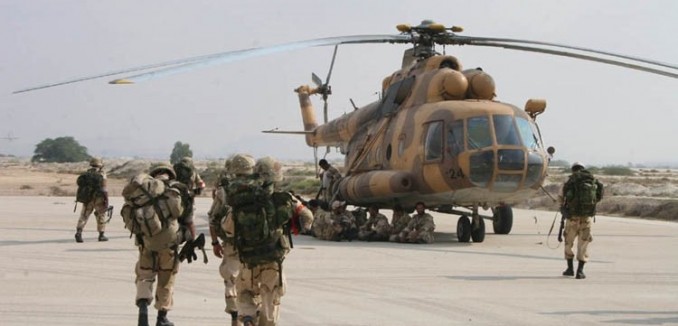In 2001, Iran’s Islamic Revolutionary Guard Corps (IRGC) established a special unit consisting of handpicked members of the IRGC’s land, sea, and air forces. Dubbed the Saberin Unit, its members were described as volunteers “seeking martyrdom,” tasked to carry out special missions and/or widespread cross-border attacks for the IRGC.
Amanollah Gashtasbi, who has led the Saberin Unit since 2014, described his group as having “a duty to confront the opponents and those ridiculing the values of the revolution. This duty has been appointed to the Saberin Unit alone and other special units have no such tasks.”
The unit first received widespread notice in 2011, when it led a crackdown on Iranian Kurdish dissidents. More recently, it has played an active role in Syria and Iraq; Mohammad Pakpour, a senior commander of the more well-known IRGC-Qods Force, admitted on February 18 that a number of Saberin troops have been killed in the two countries.
The number of Saberin casualties in Syria alone is believed to have reached the hundreds since it entered the conflict in 2012, including many high-ranking military leaders. Jahangir Jafari, commander of the 16th Quds Division Saberin Battalion, was killed in Syria on June 5 of this year. Three days later, Iranian media reported the deaths of five IRGC members in battles near Aleppo. Ali Nazari, deputy commander of the al-Mahdi Special Brigade Hamze (Saberin) Battalion from the town of Jahrom, was amongst those killed. And a September 27 statement issued by the IRGC Ansar al-Hossein Corps referred to the death of former Saberin Unit commander Mohammad Reza Zare Alavani in Syria.
Saberin continues to carry out its measures as the IRGC’s main unit in Syria, playing a direct role in the siege of Aleppo and active in command-and-control of various fronts.
In June 2014, Saberin began dispatching members to Iraq to take part in Shiite militia attacks against the Sunni population. They also took control over Iraqi Shiite militia operations and training. The following April, following a series of defeats suffered by Qods Force-affiliated Shiite militias in Iraq, the Saberin Unit began providing training to a portion of these Iraqi militias under the pretext of establishing units for battles against ISIS. A Saberin base in Kermanshah hosted a four-month training course for handpicked members of the “Popular Mobilization Forces,” as the Iraqi Shiite militias are known.
Saberin-trained soldiers who had returned to Iraq carried out a series of such attacks against Sunni populations. On August 10-11 2015, Saberin-trained militia members killed all individuals at a gathering of Sunni tribesmen in Garme, and infiltrated a tribal gathering in Saqlaviye and destroyed the site with explosives. Later that month, a Saberin Unit team, accompanied by over two dozen Qods Force advisors, infiltrated and launched an attack against a Sunni base in Garme.
Saberin Unit members in Iraq have also been charged with protecting Shiite religious sites, including those in the cities of Karbala, Najaf and Samara. These teams mainly comprise combat troops who provide defensive power for these sites. In that capacity, many Saberin members have been killed in various battles. One such casualty was a commander named Alireza Moshajari. Moshajari had played an active role alongside Shiite militias in attacks on American troops during the Iraq War. He had also been dispatched to Syria in August 2013 to support Assad forces confronting the Free Syrian Army, remaining in the country for three months. His father is a senior Quds Force Saberin Brigade commander stationed in Tehran.
Due to the importance of the Saberin Unit in pursuing Tehran’s crackdown policy and exporting fundamentalism in regional countries, the Iranian regime continuously provides special equipment to this unit. The ultralight “gyroplane,” used in special recon missions, is one such example. In October, one of the gyroplanes belonging to the Saberin Unit crashed in southeast Iran after returning from a recon mission. Ahmad Mayeli, the pilot and commander of the Saberin Unit’s air battalion, was killed alongside the co-pilot.
With Iran extremely concerned about the unpredictable outcomes of a new administration in Washington, the mullahs will most likely expand their efforts and footprints in Syria and Iraq. This will lead to further missions and a more comprehensive role for Saberin throughout the Middle East, working in parallel with other Iranian military assets.
The international community, especially the West and spearheaded by the U.S., must take a firm stance against Iran’s lethal meddling across the region. Sanctioning the entire IRGC would be a positive step forward, sending a strong message to those sitting on the throne in Tehran.
Heshmat Alavi is a political and rights activist. His writing focuses on Iran, ranging from human rights violations, social crackdown, the regime’s support for terrorism and meddling in foreign countries, and the controversial nuclear program. He tweets at @HeshmatAlavi & blogs at IranCommentary.
[Photo: Sepah News]




